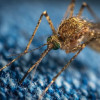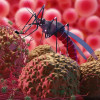
 IJCP Editorial Team
IJCP Editorial Team
Types of Viruses that Can Cause Arthritis From Hepatitis C to Chikungunya
Arthritis, a condition characterized by joint inflammation, can be caused by various factors, including viral infections. Viral-induced arthritis, also known as post-viral arthritis is a unique subset of arthritis that occurs as a result of viral infections.
Unlike other forms of arthritis caused by wear and tear or autoimmune disorders, viral arthritis is triggered by specific viruses. These viruses have the ability to invade joint tissues, leading to inflammation, pain, and swelling in the affected joints.
Hepatitis C Virus (HCV)
Hepatitis C virus (HCV) primarily affects the liver, but it can also manifest in extrahepatic manifestations, including arthritis. The prevalence of arthritis in HCV-infected individuals varies, with estimates ranging from 10% to 60%. Several mechanisms contribute to the development of HCV-associated arthritis.
One mechanism involves the deposition of immune complexes in the joints, triggering an inflammatory response. HCV infection leads to chronic stimulation of the immune system, resulting in the production of autoantibodies. These autoantibodies can form immune complexes that accumulate in the joints, leading to inflammation and arthritis.
Another proposed mechanism is molecular mimicry, where viral proteins resemble host proteins. Antibodies produced against HCV may cross-react with self-antigens, triggering an immune response against joint tissues. This molecular mimicry can result in chronic arthritis in some HCV-infected individuals.
Chikungunya Virus (CHIKV)
Chikungunya virus (CHIKV) is a mosquito-borne virus that has gained attention due to its association with arthritis. Following CHIKV infection, joint symptoms typically manifest within a few days to weeks and are characterized by severe joint pain, swelling, and stiffness. The arthritis caused by CHIKV infection can be acute, subacute, or chronic.
CHIKV-induced arthritis is thought to be driven by both viral persistence and an immune-mediated response. The virus can establish chronic infection in the joint tissues, leading to ongoing inflammation. Additionally, the host immune response plays a crucial role in the pathogenesis of CHIKV-induced arthritis. The immune system recognizes viral antigens and triggers an inflammatory response, resulting in joint inflammation.
The exact mechanisms by which CHIKV induces arthritis are not fully understood, but it has been observed that the virus can directly infect synovial cells and trigger the release of pro-inflammatory cytokines. These cytokines promote inflammation and joint destruction, contributing to the development of arthritis.
Epstein-Barr Virus (EBV)
Epstein-Barr virus (EBV), a member of the herpesvirus family, is a common viral infection that is known to cause infectious mononucleosis (also known as glandular fever) in adolescents and young adults. In addition to its association with mononucleosis, EBV has been linked to the development of arthritis in some individuals.
EBV-induced arthritis typically presents as a symmetrical polyarthritis, affecting multiple joints simultaneously. The joint symptoms can range from mild to severe and may include pain, swelling, stiffness, and limited range of motion. The arthritis associated with EBV infection can persist for weeks to months, and in some cases, it can become chronic.
The exact mechanisms by which EBV triggers arthritis are not fully understood. It is believed that the immune response to EBV plays a significant role in the development of arthritis. The virus can persist in B cells, and the immune system's response to these infected cells can result in chronic inflammation in the joints. Additionally, immune complexes formed during the course of the infection may deposit in the joints, further contributing to joint inflammation.
Adenovirus
Adenoviruses are a group of DNA viruses that can cause a wide range of respiratory and gastrointestinal infections. While adenovirus infections are typically associated with symptoms such as fever, sore throat, and cough, they have also been linked to the development of arthritis in some cases.
Adenovirus-induced arthritis primarily affects children, especially those with a weakened immune system. The exact prevalence of adenovirus-associated arthritis is not well-defined, but it is considered a relatively rare complication of the infection. It is believed that the immune response to the viral infection plays a significant role. The virus can cause an immune-mediated reaction that leads to joint inflammation and subsequent arthritis. Additionally, viral particles may directly infect joint tissues, causing local inflammation and damage.
The joint symptoms associated with adenovirus-induced arthritis typically include joint pain, swelling, and limited mobility. The arthritis may be acute, self-limiting, and resolve on its own within a few weeks, or it may persist and become chronic in some cases.
Zika Virus
Zika virus, transmitted primarily by Aedes mosquitoes, gained global attention due to its association with microcephaly in infants. In addition to neurological complications, Zika virus infection can also cause arthritis.
Joint symptoms, including pain, swelling, and limited mobility, can develop during or after the acute phase of the infection. The immune response and potential direct viral effects on joint tissues contribute to the development of Zika virus-induced arthritis.
Mumps Virus
The mumps virus is a highly contagious RNA virus that primarily affects the salivary glands but can also lead to arthritis as a complication. Mumps-induced arthritis typically presents as joint pain, swelling, and stiffness, predominantly affecting large joints. The immune response to the viral infection and potential direct viral involvement in joint tissues contribute to the development of arthritis.
Other Viruses Associated with Arthritis
In addition to HCV and CHIKV, several other viruses have been linked to the development of arthritis. These include:
1. Parvovirus B19: Parvovirus B19 infection can cause acute arthropathy, particularly in adults. It is characterized by symmetrical joint pain and swelling, often affecting the hands, wrists, and knees.
2. Rubella virus: Rubella infection, primarily known for its association with congenital defects, can also cause arthritis. It typically presents as a transient polyarthritis, affecting multiple joints.
3. Human Immunodeficiency Virus (HIV): HIV infection can lead to various rheumatic manifestations, including arthritis. HIV-associated arthritis is often symmetric and involves large joints.
Several other viruses have been linked to the development of arthritis. These include alphaviruses such as Ross River virus and Barmah Forest virus. Each virus has unique characteristics and mechanisms of arthritic involvement, often involving immune-mediated responses and inflammation in joint tissues.
Conclusion
Viral-induced arthritis encompasses a diverse range of viruses, each with its specific mechanisms and clinical presentations. Hepatitis C virus and Chikungunya virus are two notable examples of viruses that can cause arthritis. HCV-induced arthritis involves immune complex deposition and molecular mimicry, while CHIKV-induced arthritis is driven by viral persistence and an immune-mediated response.
Understanding the mechanisms behind viral-induced arthritis is crucial for accurate diagnosis and effective management. Although the specific mechanisms vary for each virus, immune-mediated responses, inflammation, and potential direct viral effects on joint tissues play significant roles.

IJCP Editorial Team
Comprising seasoned professionals and experts from the medical field, the IJCP editorial team is dedicated to delivering timely and accurate content and thriving to provide attention-grabbing information for the readers. What sets them apart are their diverse expertise, spanning academia, research, and clinical practice, and their dedication to upholding the highest standards of quality and integrity. With a wealth of experience and a commitment to excellence, the IJCP editorial team strives to provide valuable perspectives, the latest trends, and in-depth analyses across various medical domains, all in a way that keeps you interested and engaged.















Please login to comment on this article